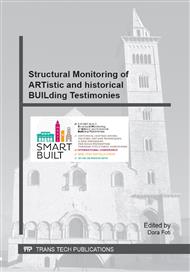p.193
p.198
p.204
p.212
p.218
p.225
p.231
p.237
p.243
Hearing the Buildings: Smart Monitoring through Advanced Sonification Approaches
Abstract:
Risk prevention of historical buildings through sensor network monitoring represents a challenging and together promising task towards an optimized buildings’ protection plan. Due to the significant character that historical buildings have within the history and identity of local and consequently national communities, the monitoring approach above is nowadays considered a fundamental component of cultural preservation. Modern trends on sensor networks nowadays allow the installation of wireless monitoring equipment, able to collect a large volume and variety of data that can be further processed in order to support prevention modelling techniques and strategies. Despite the valuable post-processing outcome of the above modelling techniques, in several real-time monitoring cases, an aspect that may significant impact the data analysis accuracy from the monitoring engineer is to create an audiovisual representation of the gathered data that are easily perceived and directly associated to well-known environmental conditions. Towards this aim, in this work an audio-based representation of the collected data is introduced that achieves high monitoring performance in terms of the perceived nature of the building vibrations themselves. The proposed audio-based representation technique is based on a number of advanced sonification methods, combined with specific human-hearing simulation mechanisms that allow an effective increase of the represented information volume in real-time. A number of subjective tests that were performed demonstrate a significant improvement on the way that the monitoring personnel can efficiently perceive the origin and / or nature of the acquired vibrations, rendering the proposed technique a strong supplement towards efficient historical building risk prevention.
Info:
Periodical:
Pages:
231-236
Citation:
Online since:
August 2014
Authors:
Price:
Сopyright:
© 2015 Trans Tech Publications Ltd. All Rights Reserved
Share:
Citation:



